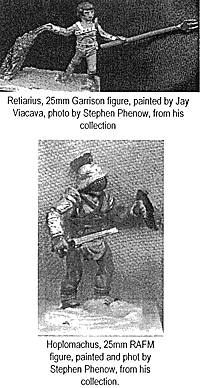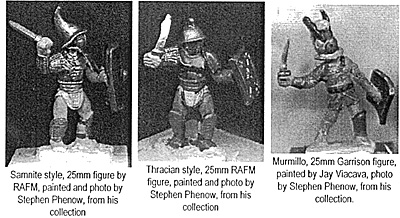 You are a gladiator in the Circus Maximus of Rome. Fight well and live to become a legend of the Arena mob. Fight poorly and die like the scum the mob thinks you are.
You are a gladiator in the Circus Maximus of Rome. Fight well and live to become a legend of the Arena mob. Fight poorly and die like the scum the mob thinks you are.
Retiarius, 25mm Garrison figure, painted by Jay Viacava, photo by Stephen Phenow, from his collection. and bottom, Hoplomachus, 25mm RAFM figure, painted and photo by Stephen Phenow, from his collection.
SETTING UP
Materials needed:
- Gladiator Miniatures any scale.
Two pair of different colored d6
an "AVE IMPERATOR" record sheet per gladiator.
Next. Choose your Gladiator and roll for how many wounds he can receive. Each gladiator is one of five styles:
First style: Retiarius (One who uses a Trident and Net)
Attack 5, Defense 1, Wounds: (1D6 Roll: 1-5=2 6=3), Move 2
(Retiarius must always be paired against a Mirmillo)
Second style: Hoplomachus (Round shield and Armor)
Attack 3, Defense 3, Wounds: (1D6 Roll: 1=2, 3-5= 3, 6=4), Move 1
(Must be paired against a Secutor)
Third style: Secutors
Samnite (Lt. scutum and Armor)
Attack 3, Defense 3, Wounds: (1D6 Roll: 1-4= 2, 5-6=3), Move 1
Thracian (Small shield and light Armor)
Attack 4, Defense 2, Wounds: (1D6 Roll: 1-4= 2, 5-6=3), Move 2
(May be paired against a Secutor, or against each other.)
Fourth Style: Gaulic (Lg scutum and Hy Armor)
Attack 2, Defense 4, Wounds (1D6 Roll: 1-2= 2, 3-5=3, 6=4), Move 1
(May be paired against Hoplomachus, Secutors.)
Fifth Style
Murmillo (Lg scutum and armor)
Attack 3, Defense 3, Wounds (1D6 Roll: 1-2=2, 3-5=3, 6=4), Move 1
(A Murmillo must always be paired against a Retiarius)
Dimachaeri (2 knives)
Attack 4, Defense 2, Wounds: (1D6 Roll: 1-5 =2, 6=3), Move 2
(May only fight another, usually at close up functions such as banquets.)
Modifiers:
Midgets (move 1) and Women (move 2) are -1 Attack and +1 Defense (Subtract one from the wound roll)
PLAY
A. Experience
All Gladiators start out as tyros. They receive no experience points. If they survive their first fight, each gladiator receives two experience points that they can use to modify their attack and/or defense value each round of combat.
After 5 fights, add an additional plus two points. This continues for every 5 fights until the gladiator is invincible, where upon be retires from the Arena, or he is killed, and a new character started.
B. Procedure
For each round of combat the gladiator players write down what their attack and defense values are on the record sheet. Move 2 gladiators move first, then Move I gladiators. If the gladiators are the same Move number they move simultaneously. (Optional Rule: a Move 2 gladiator may be able to get in a better position to attack than a Move 1 gladiator. The Move 2 gladiator rolls a d6 +1 against the Move 1 gladiators d6. Should the Move 2 gladiator win, be gets a better attack-, add +1 to his attack total.)
They both then roll two different colored d6, denoting which color will be the defense die and which will be the attack die. The attack die result is added to their written attack value and the defense die to their written defense value. If a gladiator's total attack value beats his opponent's defense value and his total defense value beats his opponent attack value, he has scored and inflicts a wound on his opponent. If the total of the scoring attack total is double that of the opponent's defense total, two wounds are inflicted. Any other result is considered a tie with the gladiators parrying each other. Continue to another round of combat. (Optional Rule: Move 2 gladiators may roll combat dice before a Move 1 opponent.)
C. Wounds
For each wound a gladiator loses one experience point to his defense. If the Gladiator's wounds match his wound total he passes out, and the bout is over iIf the Gladiator's wounds exceeds his wound total he dies, and the bout is over.
D. Exhaustion
After each 5 rounds the gladiators are tiring and are reduced one point on both their Attack and Defense values.
VICTORY
A. Clear Victor
If the Gladiator passes out, the bout is over, and the Victor asks the Editor of the Games for the decision. The longer the fight went, the better the chance the loser would be spared. Roll one d-6 and add to it the number of rounds played. If the total exceeds 8, the loser is spared. If not, summon Charon to carry him to the underworld.
B. No Clear Victor
After 15 total rounds without a victor the Mob is bored. The Emperor will pick a victor based on the following criteria. +1 each wound inflicted. +1 If the gladiator was a Secutor* (*They were crowd favorites)
Roll 1d6 per gladiator. Gladiator with the highest total wins, and adds the fight to his experience. The other gladiator receives no experience. A draw means that both fighters count towards experience.
 Left: Samnite style, 25mm figure by RAFM, painted and photo by Stephen Phenow, from his collection
Left: Samnite style, 25mm figure by RAFM, painted and photo by Stephen Phenow, from his collection
Middle: Thracian style, 25mm RAFM figure, painted and photo by Stephen Phenow, from his collection
Right: Murmillo, 25mm Garrison figure, painted by Jay Viacava, photo by Stephen Phenow, from his collection.
Credits:
Design and Development: Steve Verdoliva.
Editor and historical additions: Stephen Phenow
More History of the Munus Gladiatorial Contests
-
Origins
The First Contests in Rome
The Games as a Political Tool
The Demise of the Munus
Ave Imperator: Gladiator Game Rules
Ave Imperator: Record Sheet
Re-enactor: Maximus the Lanista
More History of the Munus Part 2 Gladiatorial Contests
-
Executing the Munus
The Preparation
Conduct of the Gladiatorial Contests
The Fight and Post Combat
Gladiators and Their Future
Back to Strategikon Vol. 1 No. 3 Table of Contents
Back to Strategikon List of Issues
Back to MagWeb Master Magazine List
© Copyright 2001 by NMPI
This article appears in MagWeb (Magazine Web) on the Internet World Wide Web. Other military history articles and gaming articles are available at http://www.magweb.com